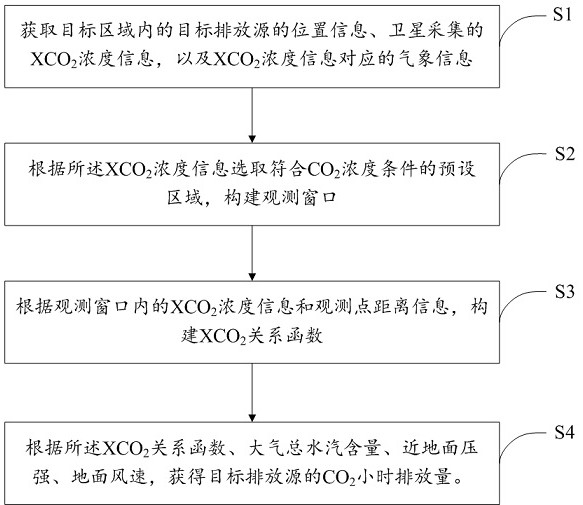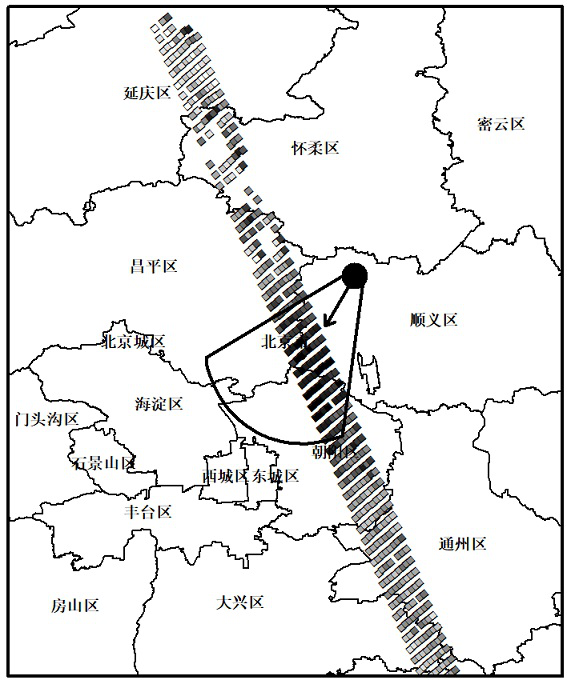Method and system for monitoring CO2 hour emission amount of emission source in target area through satellite
A target area and emission source technology, which is applied in the field of satellite monitoring CO2 hourly emissions of emission sources in the target area, can solve the problems of increasing manpower and material costs, large-scale monitoring, etc., and achieve reduced manpower and material costs, high operating speed, and The effect of accurate calculation results
- Summary
- Abstract
- Description
- Claims
- Application Information
AI Technical Summary
Problems solved by technology
Method used
Image
Examples
Embodiment 1
[0053] This embodiment provides a satellite monitoring target area emission source CO 2 Hourly emissions methods such as figure 1 shown, including:
[0054] S1: Obtain the location information of the target emission source in the target area and the XCO collected by the satellite 2 Concentration information, and XCO 2 Meteorological information corresponding to the concentration information.
[0055] The satellite acquired XCO 2 The concentration information is characterized as the XCO obtained by the satellite at the time of satellite transit in the downwind direction of the emission source. 2 Distributing strip-shaped areas, the emission sources include target emission sources.
[0056] At the downwind position of the emission source, obtain the XCO near the emission source position through satellite 2 Concentration distribution, according to the size of the concentration value, use different colors to judge different concentration values, and draw the satellite observ...
Embodiment 2
[0094] This embodiment provides a satellite monitoring target area emission source CO 2 Hourly emissions systems such as Figure 5 shown, including:
[0095] The acquisition module 50 acquires the location information of the target emission source in the target area and the XCO collected by the satellite 2 Concentration information, and XCO 2 Meteorological information corresponding to the concentration information;
[0096] window building block 51, according to the XCO 2 The concentration information is selected according to CO 2 Preset area of concentration condition, build observation window;
[0097] The function building module 52, according to the XCO in the observation window 2 Concentration information and observation point distance information to construct XCO 2 relational function;
[0098] Emissions determination module 53, based on the XCO 2 relationship function, total atmospheric water vapor content, near-surface pressure, and surface wind speed to ob...
Embodiment 3
[0115] The emission source CO is stored on the computer-readable storage medium provided by the present invention 2 Hourly emission monitoring program, the emission source CO 2 When the hourly emission monitoring program is executed by the processor, a satellite monitoring target area emission source CO provided by the present invention is realized 2 Steps of the Hourly Emissions Method.
PUM
 Login to View More
Login to View More Abstract
Description
Claims
Application Information
 Login to View More
Login to View More - R&D
- Intellectual Property
- Life Sciences
- Materials
- Tech Scout
- Unparalleled Data Quality
- Higher Quality Content
- 60% Fewer Hallucinations
Browse by: Latest US Patents, China's latest patents, Technical Efficacy Thesaurus, Application Domain, Technology Topic, Popular Technical Reports.
© 2025 PatSnap. All rights reserved.Legal|Privacy policy|Modern Slavery Act Transparency Statement|Sitemap|About US| Contact US: help@patsnap.com



